
By: Rick Greenwald, David C. Kreines (Editor)
Paperback: 912 pages 1st Edition edition (December 1, 2002)
O'Reilly & Associates
Introduced a quarter-century ago, the Oracle database remains the leading enterprise relational database management system (RDBMS) in the world. Oracle is a complex system, offering a myriad of products, languages, and tools. Frequent updates, releases, and editions complicate the ability of Oracle users to keep up with the huge amounts of frequently changing information about the database and its capabilities. The goal of Oracle in a Nutshell is to bring order to the chaos of Oracle informatio n -- to pull together the most essential information on Oracle architecture, syntax, and user interfaces. The content and format of this book, an admirable addition to O'Reilly's respected In-a-Nutshell line, combine to boil down vital Oracle commands, language constructs, parameters, and file formats in a succinct and highly accessible desktop reference. Oracle in a Nutshell covers the information that database administrators PL/SQL and Java developers, and system, network, and security admini strators need as they manage Oracle databases and write code for these databases.
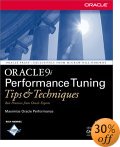
By: Rich Niemiec, Richard J. Niemiec, Bradley D. Brown, Raymond J. Lane
Paperback: 816 pages (December 2002)
McGraw-Hill Osborne Media
From the exclusive publishers of Oracle Press books comes a unique volume, packed with undocumented tips & techniques, for tuning and tailoring Oracle9i to perform at its peak. Author Rich Niemiec has been named by Oracle Corporation as one of the top six Oracle experts in the world!
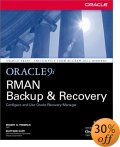
By: Robert G. Freeman, Matthew Hart
Paperback: 608 pages (October 18, 2002)
McGraw-Hill Osborne Media
From the exclusive publishers of Oracle Press Books, here is the only book available offering complete coverage of RMAN (Recovery Manager), Oracle's free backup and recovery technology. An indispensable resource for new Oracle users, database administrators, and system administrators.

By: Kevin Loney, George Koch
Paperback: 1256 pages Book & Cd edition (August 16, 2002)
McGraw-Hill Osborne Media
The latest version of this popular guide introduces the fundamental commands and techniques used in Oracle 9i database systems, and how to develop applications using Oracle and SQL. The authors also review PL/SQL structures, object-oriented and Java features in the Oracle database, the data dictionary, database optimizers, and the application server. The CD-ROM contains an electronic version of the book and tables. Master all the powerful features of Oracle9i using the exclusive information ins ide this indispensable resource. Written by best-selling Oracle Press authors Kevin Loney and George Koch, this volume explains how to implement all the components of Oracle9i. This is a must-have reference for all Oracle professionals.
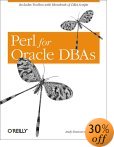
By: Andy Duncan, Jared Still
Paperback: 600 pages 1st edition (August 15, 2002)
O'Reilly & Associates
Perl is a very powerful tool for Oracle database administrators, but too few DBAs realize how helpful Perl can be in managing, monitoring, and tuning Oracle databases. Whether you're responsible for Oracle9i, Oracle8i, or earlier databases, you'll find Perl an invaluable addition to your database administration arsenal. You don't need to be a Perl expert to use the excellent applications and scripts described in Perl for Oracle DBAs. The book explains what you need to know about Perl, provides a wealth of ready-to-use scripts developed especially for Oracle DBAs, and suggests many resources for further exploration. The book covers: The Perl language -- an introduction to Perl, its rich history and culture, and its extensive text processing and data transformation capabilities. The Perl/Oracle architecture -- Detailed information about Perl DBI, DBD::Oracle, the Oracle Call Interface (OCI), Oracle::OCI, extproc_perl, and mod_perl, the modules that allow Perl programs to communicate wi th Oracle databases. Perl applications for Oracle DBAs -- Profiles of the best Perl open source applications available for use and customization by Oracle DBAs: Perl/Tk, OraExplain, StatsView, Orac, DDL::Oracle, SchemaDiff, Senora, DBD::Chart, SchemaView-Plus, Oracletool, Karma, Embperl, and Mason. The Perl Database Administration (PDBA) Toolkit -- a comprehensive suite of specialized, ready-to-use scripts designed to help Oracle DBAs perform both routine and special-purpose administrative tas ks: monitoring the Oracle alert log and databases, creating and managing Oracle user accounts, maintaining indexes and extents, extracting DDL and data, troubleshooting and tuning database problems, and much more.

By: Jim McDaniel, Patrick McGrath
Paperback: 128 pages 1st edition (August 15, 2002)
O'Reilly & Associates
The Tool for Oracle Application Developers (TOAD) is a popular graphical user interface for the Oracle database that allows programmers to build, test, debug, an format their code within an interactive development environment. With the easy-to-use TOAD interface, changes that once took hours can be done in just minutes. TOAD allows developers to browse their database tables, procedures and object types, use code templates, and shows errors. It also simplifies database administration by providing a way for DBAs to graphically browse and change database characteristics. The only book in print for the current version of TOAD (7.4), the TOAD Pocket Reference for Oracle , provides Oracle developers and DBAs with quick reference to TOAD?s main features, shortcut keys, recommended changes to options, and productivity tips and tricks.

By: John Adolph Palinski
Paperback: 528 pages 1st edition (August 8, 2002)
Addison Wesley Professional
Introduces the basic relational database terminology and techniques for extracting information from Oracle databases. Written for beginners, the book focuses on the SQL*Plus query language and the SELECT command for querying a database. Business objects and data warehouses are briefly covered. The final three chapters overview the PL/SQL programming language. The CD-ROM contains a practice database and sample scripts

By: Marlene Theriault, Rachel Carmichael, James Viscusi, Jim Viscusi
Paperback: 576 pages 1st edition (July 15, 2002)
Osborne McGraw-Hill
Your Oracle career starts here! Ideal for those new to Oracle technology, this introductory guide explains in easy-to-follow detail the day-to-day duties of a database administrator (DBA), as well as essential database installation, monitoring, and managing techniques.
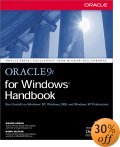
By: Rama Velpuri, Anand Adkoli
Paperback: 528 pages 2 edition (April 19, 2002)
Osborne McGraw-Hill
This authorized guide from Oracle Press explains how to implement the Oracle9i Server on Windows NT/2000. You'll get details on operating system fundamentals, installation, and configuration, plus intermediate and advanced topics such as architecture, migration, clustering, parallel server
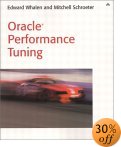
By: Edward Whalen, Mitchell Schroeter
Paperback: 432 pages 1st edition (April 16, 2002)
Addison Wesley Professional
Edward Whalen is vice president and founder of Performance Tuning Corporation (perftuning), a consulting company that specializes in database performance, administration, and backup/recovery solutions. He has extensive experience in database system design and tuning for optimal performance. His career has consisted of hardware, operating system, and database development projects for many different companies. Edward has published two other books on the Oracle RDBMS. He has also written four books on Microsoft SQL Server. In addition to writing, Edward has worked on numerous benchmarks and performance-tuning projects with both Oracle and MS SQL Server. Mitchell Schroeter is a senior consultant with Performance Tuning Corporation (perftuning) and has worked in the field of database performance tuning for five years. Prior to Performance Tuning Corporation, Mitchell worked at Dell Computer Corporation as a systems analyst in the systems performance analysis group, specializing in database technologies and high-performance storage systems. He has extensive experience with developing client-server and multitiered applications on both Oracle and Microsoft SQL Server in a variety of programming languages. Mitchell specializes in tuning database systems and application code, storage area networks, and Oracle 9i Real Application Clusters.
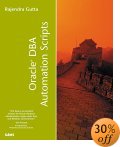
By: Rajendra Gutta
Paperback: 408 pages 1st edition (April 11, 2002)
Sams
Provides and explains powerful scripts that automate common database administration tasks, empowering the DBA to spend more time focusing on the critical aspects of their job.

By: Tim Donar
Paperback: 285 pages 1st edition (March 31, 2002)
Butterworth-Heinemann
Step-by-step configuration guide for Tru64 UNIX 5.1 TruCluster and Oracle9i RAC. Oracle9i RAC installation and configuration tips. Command summary included in each chapter. This quick reference provides step-by-step instructions on setting up Oracle9i RAC to run on a Tru64 UNIX cluster. Configuration information is included from start to finish. Command summary guides are built into each chapter for quick information retrieval. Examples and step-by-step instructions assist in the complete inst allation of a Tru64 UNIX 5.1A and Oracle9i. Designed as an introduction to Tru64 UNIX and Oracle9i RAC, Tru64 UNIX-Oracle9i Cluster Quick Reference will give intermediate and advanced administrators an invaluable resource for quickly locating vital information.
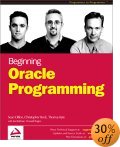
By: Sean Dillon, Christopher Beck, Thomas Kyte, Joel Kallman (Contributor), Howard Rogers
Paperback: 1000 pages 1st edition (March 2002)
Wrox Press Inc
Oracle is the world's leading relational database. It provides a rich environment to store, handle, and extract data. When used properly, Oracle provides a solid foundation upon which to build enterprise scale applications. Mastering the Oracle database is not an overnight job. It takes time, practice, and a lot of real world experience. This book teaches you the core concepts behind using the database, shows you the tools and techniques you need to master, and gives you practical examples of p rogramming Oracle. By the time you have completed this book, you will have all the knowledge you need to use Oracle databases with confidence. You are setting out on the same journey we travelled some years ago. We know the things you are going to run into time and time again. We understand the challenges you are going to meet when you have to develop an application or administer your database. We can guarantee you that the techniques you'll learn in this book are proven and have led us through many successful implementations.
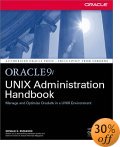
By: Donald K. Burleson, Don Burleson
Paperback: 560 pages (January 16, 2002)
Osborne McGraw-Hill
This is a very interesting read for any Unix DBA, full of comprehensive explanations and diagrams on the way in which Oracle interacts with the Unix server. There are many detailed Unix Scripts to help you monitor your instances, which can be run via Statspack (dbms_job) and/or via the Unix cron. There is additional information on some more complicated UNIX commands, and copious small tips and tricks that will help in everyday Database Administration tasks. The book also covers commands for all different Unix environments Solaris, HP-UX, Tru64, AIX etc and help you interpret results from vmstat, sar and other Unix admin utilities.
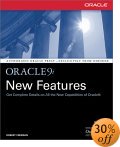
By: Robert G. Freeman
Paperback: 244 pages (January 4, 2002)
Osborne McGraw-Hill
Maximize all of the enhanced capabilities of Oracle9i using the precise information presented in this convenient resource, officially authorized by Oracle Corporation. Inside, you'll find full details on all the new Oracle9i features, including database administration and management improvements, architecture changes, performance enhancements, security advancements, and high-availability innovations.

By: Robert G. Freeman, Mark D. Blomber, Mark D. Blomberg
Paperback: 1200 pages Bk & Cd-Rom edition (December 13, 2001)
Sybex
Massive in size, comprehensive in scope, and unfortunately quite dry in tone, Mastering Oracle 8i has the answers you need if you're working with the Oracle 8i database management system. The authors, one of whom holds an Oracle certification, go into considerable detail on the procedures to be followed for administrative tasks like backing up data, rolling back transactions, and configuring monitoring schemes. They usually share their thoughts on when and why you'd want to put the procedures to use, as well. Better yet, they go beyond everyday administrative work to cover subjects like materialized views, advanced user management, and performance-tuning techniques. There's some discussion of hooks for software developers, as well. The authors' approach is to take a feature of the Oracle 8i environment--locks, say--and explain what purpose it serves, then break it down into component types with more detailed explanations. From there, the authors provide the commands and codes for view ing and manipulation of the feature, often with extensive tables. The really useful information comes next, in the form of sections on how to deal with related problems. The section on locks, for example, shows how to zero in on blocking locks. Other excellent coverage deals with how to dimension hardware, while a commendable section explains the object-oriented features of Oracle 8i.
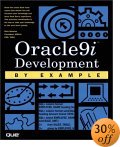
By: Dan Hotka
Paperback: 640 pages 1st edition (December 12, 2001)
Que
Learn the ins and outs of the Oracle9i development environment from product installation to advanced management configuration. Oracle 9i Development by Example provides coverage of everything from building, monitoring, and tuning an Oracle9i database to building forms and reports using developer 6i to understanding newer tools such as Log Miner in an easy to learn format.
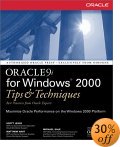
By: Scott Jesse, Matthew Hart, Mike Sale
Paperback: 612 pages 1st edition (December 7, 2001)
Osborne McGraw-Hill
From the authorized Oracle Press comes a unique volume, packed with undocumented tips ; techniques from Oracle experts, for maximizing Oracle9i on the Windows 2000 platform. You'll get full coverage of critical high-end features such as clustering and standbys and methods for ensuring high availability. You'll also get full details on all the features new to Oracle9i. Take full advantage of the strength and reliability of Oracle9i and the management features of Windows 2000. Written by the expe rts and authorized by Oracle Corporation, Oracle9i for Windows 2000 Tips & Techniques presents insider best practices for installation, upgrades, migration, tuning, backup and recovery, clustering, and high availability. You'll also get in-depth details on the new features of Oracle9i.
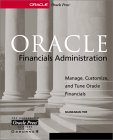
By: Shankaran Iyer
Paperback - 704 pages 1st edition (December 4, 2001)
McGraw-Hill Professional Publishing
From the official Oracle Press comes a comprehensive guide managing, customizing, and tuning this key component of the Oracle Applications Suite. You'll learn to install and update Oracle Financials, apply various patches, and much more using this essential resource.

By: Michael Wessler
Paperback - 600 pages 1st edition (October 29, 2001)
Sams
Oracle DBA on Unix and Linux provides all the information needed to install, support, tune, and upgrade Oracle databases on the UNIX and Linux platforms. Maintain a robust, mission-critical Oracle8i database. This book provides administrative solutions for the day-to-day DBA. You'll learn how to install the database for maximum efficiency, upgrades, patches, migrations, tune, and maintain its security. The book also explains in detail how to build and support a fully functioning Oracle database. This authoritative text contains up-to-date information available on Oracle's latest release and shows you how to: configure database architecture; install and set up with UNIX requirements; create the actual database with scripts; GUI management products; use Backup and Recovery; tune, monitor, and troubleshoot servers; Web DB and the Oracle Portal, 8i, iFS, Java, and 9i coverage; and iAS - Internet Application Server.

By: Donald K. Burleson (Editor)
Paperback - 896 pages (July 30, 2001)
Auerbach Publications
If you are a typical Oracle professional, you don't have the luxury of time to keep up with new technology and read all the new manuals to understand each new feature of the latest release from Oracle. You need a comprehensive source of information and in-depth tips and techniques for using the new technology. You need Oracle Internals: Tips, Tricks, and Techniques for DBAs.Oracle has evolved from a simple relational database into one of the most complex e-commerce platforms ever devised. It's n ot enough for you to understand just the Oracle database. You must also understand the components of the Web server technology, XML, Oracle Security, Oracle and Java, and a host of other issues in order to do your job properly. This book is a compendium of the best and most useful articles form Oracle Internals, Auerbach Publications' newsletter for Oracle database administrators and other Oracle professionals. Edited by Oracle guru Don Burleson, it provides the type of in-depth, highly technica l information not found in any other book, information only available from peers and consultants. The chapters focus on the truly tough stuff - proven techniques learned in the trenches. You could get this information from other sources, but you'd have to hunt and peck for it. Can you afford that kind of time? Oracle Internals: Tips, Tricks, and Techniques for DBAs gives you knowledge and advice directly applicable to your work in one easy-to-use resource.

By: Thomas Kyte
Perfect Paperback - 1265 pages (June 2001)
Wrox Press Inc
Tom Kyte is of a rare breed. To begin, he's technically expert in his subject (administration of and development of applications for Oracle database management systems). What's more (and what distinguishes him from the ranks of the super-competent), he is both able and willing to share his considerable store of wisdom with Oracle users via books like Expert One on One: Oracle. Perhaps the best book about Oracle products ever put out, this book is a model of all aspects of technical publishing: s cope, level of detail, clarity of explanations, and quality of examples. It's pretty much certain that you will learn a great deal about Oracle from Kyte's work, and that you'll become more capable in your work as a result of studying this book. Kyte - it's very tempting to call him an Oracle oracle - seems not to have had to struggle to fit his message into the Wrox Press form, which relies on a running commentary interspersed with code listings and conceptual diagrams. Kyte's commentary is em inently informed and packed with references to the differences between that which is ideal and that which often must be done to accommodate reality. He takes care to explain how little-known pieces of the Oracle environment - and alternative ways of looking at the more familiar ones - solve problems, an approach that leads to elegant, efficient solutions. Kyte boosts his readers across the chasm that separates people who can write applications for Oracle databases from people who understand Orac le databases.

By: Donald K. Burleson
Paperback - 109 pages (May 2001)
O'Reilly & Associates
The Unix for Oracle DBAs Pocket Reference has a remarkably tight focus. It's about making Oracle database management systems run optimally under various Unix operating systems, including HP-UX, Sun Solaris, and IBM AIX (there's also some specialized coverage of IRIX and DEC Unix). Author Donald Burleson assumes readers know how to get around the Unix command shell, and that they're quite familiar with Oracle database administration. To put it simply, to get the most out of this book, you should already know what you want to do, and need only to be told concisely how to do it. This book is ideal for people moving from Oracle administration under Windows to the same job under Unix.
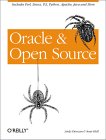
By: Andy Duncan, Sean Hull
Paperback - 400 pages (April 15, 2001)
O'Reilly & Associates
Oracle & Open Source is the first book to tie together the commercial world of Oracle and the free-wheeling world of open source software. As this book reveals, these two worlds are not as far apart as they may seem. Today, there are many excellent and freely available software tools that Oracle developers and database administrators can use, at no cost, to improve their own coding productivity and their system's performance. Moreover, many of the finest Oracle developers are now making thei r source code freely available so their peers can build upon this code base. Oracle Corporation is even porting its RDBMS to Linux and starting to incorporate a growing number of open source tools in the company's own software. Oracle & Open Source describes close to 100 open source tools you can use for Oracle development and database administration, from large and widely known open source systems (like Linux, Perl, Apache, TCL/Tk and Python) to more Oracle-specific tools (like Orasoft, Ora c, OracleTool, and OraSnap). You'll learn how to obtain the software and how to adapt it to best advantage. The book abounds with code examples, download and installation instructions, and helpful usage hints. Not only does it tell you how to find and use existing open source code; Oracle & Open Source gives you the details and the motivation to build your own open source contributions and release them to the Oracle community. You'll lear n all about tools like the Oracle Call Interface (OCI) and Perl-DBI (Database Interface), which provide the glue allowing new open source tools to link into commercial Oracle software. With Oracle & Open Source as a guide, you'll discover an enormous number of highly effective open source tools, while getting involved with the thriving community of open source development.

By: Revealnet Staff (Editor)
Paperback - 80 pages (April 15, 2001)
O'Reilly & Associates
Oracle database administration is a complex and stressful job. Pocket guide and quick reference to Oracle DBA, containing easy-to-use checklists for common database administration tasks. Includes coverage of database management, installation and configuration, and network management. Also includes step-by-step quick reference material. In a series of easy-to-use checklists, this concise pocket reference summarizes the enormous number of tasks you must perform as an Oracle DBA. Each section takes a step-by-step "cookbook" approach to presenting DBA quick-reference material. This book's quick-reference, step-by-step approach takes the stress out of DBA problem solving by making it easy to find the information you need - and find it fast.

By: Jonathan Gennick, Sanjay Mishra
Paperback - 251 pages 1st edition (April 15, 2001)
O'Reilly & Associates
SQL*Loader is a ubiquitous tool in the Oracle world. It has been shipped with Oracle since at least Version 6 and continues to be supported and enhanced with each new version of Oracle, including Oracle8 and Oracle8i. The job of SQL*Loader is to load data from flat files into an Oracle database. It's optimized for loading large volumes of data, and is flexible enough to handle virtually any input format. Almost every Oracle user has to use SQL*Loader at one time or another, and DBAs are frequent ly called upon to load data for the users in their organization. Despite SQL*Loader's wide availability and usage, few DBAs and developers know how to get the most out of it. Oracle SQL*Loader: The Definitive Guide has everything you need to know to put SQL*Loader to its best use: an introduction to SQL*Loader, a reference to all of its syntax options, and most importantly, step-by-step instructions for all the SQL*Loader tasks you'd want to perform - and maybe some you didn't realize you COULD perform.
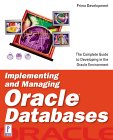
By: Steve Lemme, John R. Colby
Paperback - 418 pages (February 2001)
Premier Press, Inc
Oracle database administration goes far beyond installation and tuning of the database - topics covered by the majority of books on the market. As DBAs become more involved in the business process, architecture, and planning, there may be more to do up front, but the end result is less chaotic. To better prepare those who are up to the new eBusiness challenges, the chapters in this book have been organized with information to not only provide IT professionals with information that can be applied for a more challenging and successful career, but also for those companies who are trying to attract and retain them.
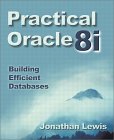
By: Jonathan Lewis
Paperback - 640 pages 1st edition (January 15, 2001)
Addison-Wesley Publishing Company
A lot of books seem to give canned explanations of how oracle works - geared towards rote memorization as opposed to understanding. This book does a great job of taking the next step. For example, The detail with which the author goes through the process of how updating a row actually works in an Oracle database was tremendous. His explanation of how a select statement could actually cause a row to be marked as committed ( i.e. a read causes a write ) was great. I've only been a DBA (or pseudo-D BA) for about 6 months now, so I'm certainly no expert in this area. Yet I found all of his explanations very clear and easy to understand. If you're looking for a new Oracle book, get this one.
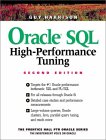
By: Guy Harrison
Paperback - 656 pages 2nd edition (December 29, 2000)
Prentice Hall
A guide for Oracle developers and database administrators, covering every aspect of Oracle 8/8i SQL and PL/SQL tuning, with specific recommendations, detailed case studies, and real benchmarks. Coverage includes designing applications to maximize efficiency, building indexes, identifying and resolving Oracle Server bottlenecks, fixing poorly performed SQL code, and leveraging Oracle's parallel query facility.

By: Melanie Caffrey, Douglas Scherer
Paperback - 457 pages 1st edition (December 15, 2000)
Prentice Hall
The Oracle DBA Interactive Workbook presents an introduction to Oracle database administration in a unique and highly effective format. It is organized more like a teaching aid than a reference manual in that to learn basic administration techniques, you are challenged to work through a set of guided tasks rather than to read through descriptions. There is a list of additional reading material in Appendix B that you can reference if you wish to delve deeper into any of the topics covered in this book. This book is intended for beginners in the world of Oracle database administration. It will take you through a set of tasks, starting with creating a database to using some of the Oracle database tuning, and backup and recovery utilities. Those experienced with Oracle databases will recognize that a workbook covering the topic of database administration will be an extremely useful introduction for the beginner, but it cannot be used as a deep study of the Oracle database environment. Aft er working through this book, you will have been launched into the exciting and interesting (sometimes nerve-racking) world of database administration, but it will take years of experience to become a senior database administrator. This book is intended for anyone who needs a quick and detailed introduction to Oracle database administration tasks. It is not the intention of this book to provide an in-depth study of the Oracle database server. The foundation for this book was developed to supplem ent the Introduction to Oracle Database Administration class in the Database Track at Columbia University's Computer Technology and Applications (CTA) program in New York City. The book's sidebars and answers often reflect questions that students have asked in class.

By: Melanie Caffrey, Douglas Scherer
Paperback Video and Book edition (December 2000)
Prentice Hall
This video course contains three-and-a-half hours of QuickTime video instruction plus the Oracle Interactive Workbook e-Book. Caffrey and Scherer (database development and management, Columbia U. School of Continuing Education) present 17 video lectures that cover all key aspects of day-to-day Oracle database administration including creating new datasets; managing physical database layouts; administering users, privileges, and resource groups; tuning Oracle and SQL code for maximum performance; security, auditing, and data integrity; logical and practical backup and recovery; auditing; rollback segments; and other topics.
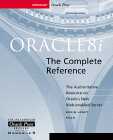
By: Kevin Loney, George K. Koch
Hardcover - 1308 pages (May 23, 2000)
Osborne McGraw-Hill (Oracle Press)
Provides a comprehensive understanding of database development on the Internet. DBAs will benefit from coverage on the Web Development environment usage and the Internet File System (IFS) feature. Describes the scalable, integrated and robust Java Virtual Machine (JVM) which allows DBAs to write, store, and execute Java code. CD-ROM offers scripts and codes from the book.
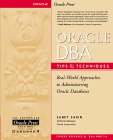
By: Sumit Sarin
Paperback - 737 pages 1st edition (April 15, 2000)
Osborne McGraw-Hill
Oracle DBA Tips & Techniques is the perfect complement to Oracle Press DBA Handbooks and soon-to-be published Starter Kit. The book is organized and structured to provide time-saving, undocumented methods for the DBAs comprehensive job. The Oracle Tips & Techniques Series is a response to the many requests for this type of material from the readers of Oracle Press. Important features include: "Tips Covered" and "Tips Reviewed" section at the beginning and end of each chapter; easy-refere nce bleed tabs.
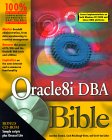
By: Jonathan Gennick, Carol McCullough-Dieter, Gerrit-Jan Linker
Paperback - 1113 pages Bk & Cd Rom edition (April 2000)
Hungry Minds, Inc
Oracle 8i is packed with new features, including an embedded Java Virtual Machine, expanded data warehousing capabilities, and enhanced DBA tools. This comprehensive guide shows you step-by-step how to make the most of this improved functionality - and master the day-to-day tools and challenges of Oracle database administration. From SQL Plus basics and performance-tuning options to recovery tips and WebDB strategies, Oracle 8i DBA Bible is all you need to optimize a database and keep it running smoothly.
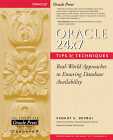
By: Venkat S. Devraj
Paperback - 1008 pages (November 1999)
Computing McGraw-Hill (Oracle Press)
Time-tested information--Strategies come straight from an Oracle DBA who's worked in the trenches for the Quatar Government keeping systems online 24x7. 8i Coverage--Version 8i's web functionality makes working in 24x7 mode available to a wider spectrum of corporations. Specific discussions--Covers areas of database installation, configuration, and management of security, performance, and recoverability. Diagnostic and database monitoring scripts--Scripts can be deployed immediately to help DBAs achieve high-availability databases.

By: Rick Greenwald, Jonathan Stern, Robert Stackowiak
Paperback - 355 pages (November 1999)
O'Reilly & Associates
The Oracle relational database management system (RDBMS) is an enormous system, with myriad technologies, options, and releases. Most users -- even experienced developers and database administrators -- find it difficult to get a handle on the full scope of the Oracle system. And as each new version of the database is released, users find themselves under increasing pressure to learn about a whole range of new technologies. This book distills the enormous amount of information about what Oracle i s, where it came from, and what the latest releases (Oracle8 and Oracle8i) do -- and packages it into a compact, easy-to-read volume filled with focused text, illustrations, and helpful hints for DBAs and developers. It explains what is new and important about Oracle's revolutionary releases, Oracle8 (the "object-relational database") and Oracle8i (the "Internet database"). It covers such topics as overall system products, architecture, and data structures; installation, management, security, ba ckup and recovery, and tuning issues; and specific Oracle technologies such as data warehouses, online transaction processing (OLTP), and the system's interfaces to the Web.

By: Michael R. Ault
Paperback - 1024 pages Bk & CD-ROM edition (October 20, 1999)
John Wiley & Sons
Oracle database administrators always have plenty on their plate. Oracle8i Administration and Management comes to the rescue with lots of guidance in creating and maintaining Oracle databases and keeping them running at top performance. This is the latest revision of the DBA guide that has previously covered Oracle7 and, more recently, Oracle8. This update adds full coverage of Oracle 8i and includes an integrated discussion of the new version's object-oriented additions to the popular SQL data base product. Author Michael R. Ault meticulously goes through the topics administrators care about most, presenting a detailed discussion of the underlying architectural details. By organizing chapters according to administrative functions, such as "Tuning Oracle Applications" and "Database Internals Tuning," Ault has created a text that is quite handy for on-the-spot reference. A number of useful appendices on the companion CD-ROM offer plenty of useful management tidbits, as well as all of t he code scripts used in the book and demonstration versions of management utilities.

By: Kevin Loney, Marlene L. Theriault
Paperback - 979 pages (October 12, 1999)
Osborne McGraw-Hill (Oracle Press)
A thorough overhaul of the previous edition - widely considered the Oracle DBA "bible" - wth full coverage of all the new Oracle8i features. Covers everything the administrator needs to know to effectively manage a robust, peak-performance Oracle8i database. Explains how to configure Oracle to be accessed through a firewall from a DBA's perspective. "Solutions" sections illustrates - with annotations - how to implement the techniques described in each chapter. Maintain a robust, mission-critical Oracle8i database - the most manageable Web-enabled enterprise database system available. Oracle8i DBA Handbook provides high-end administrative solutions for the day-to-day DBA. Inside, you'll learn to set up a database for maximum efficiency, monitor it, tune it, and maintain its security.

By: Charles Dye, Deorah Russell (Editor), Deborah Russell (Editor)
Paperback - 530 pages Bk & Disk edition (April 1999)
O'Reilly & Associates
Most organizations that use the Oracle relational database management system (RDBMS) these days need to use multiple databases. There are many reasons to use more than a single database in a distributed database system: Different databases may be associated with particular business functions, such as manufacturing or human resources. Databases may be aligned with geographical boundaries, such as a behemoth database at a headquarters site and smaller databases at regional offices. Two different d atabases may be required to access the same data in different ways, such as an order entry database whose transactions are aggregated and analyzed in a data warehouse. A busy Internet commerce site may create multiple copies of the same database to attain horizontal scalability. A copy of a production database may be created to serve as a development test bed.
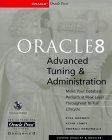
By: Eyal Aronoff, Kevin Loney, Noorali Sonawalla
Paperback - 660 pages (June 9, 1998)
Osborne McGraw-Hill (Oracle Press)
Picks up teaching Oracle skills where Oracle8 DBA Handbook and Tuning Oracle leave off. Gives Oracle8 DBAs the advanced tools necessary to manage and tune their databases regardless of the rate of growth in the environment--a very important scalability skill. Revised to cover all new aspects of Oracle8, including: Partitioned tables, abstract datatypes, index-only tables, objects, and more. CD-ROM includes code from the book, plus a new version of SQLab--a valuable application tool that help rea ders practice advanced optimization techniques. The previous edition sold over 25,000 copies, and this new version gives Oracle8 DBAs the advanced tools necessary to manage and tune their databases regardless of the rate of growth in the environment. The CD-ROM includes code from the book plus a new version of SQLab.
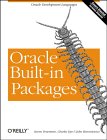
By: Steven Feuerstein, Charles Dye, John Beresniewicz
Paperback - 956 pages (May 1998)
O'Reilly & Associates
Oracle is the most popular database management system in use today, and PL/SQL plays a pivotal role in current and projected Oracle products and applications. PL/SQL is a programming language providing procedural extensions to the SQL relational database language and to an ever-growing number of Oracle development tools. Originally a rather limited tool, PL/SQL became with Oracle7 a mature and effective language for developers. Now, with the introduction of Oracle8, PL/SQL has taken the next ste p towards becoming a fully realized programming language providing sophisticated object-oriented capabilities. Steven Feuerstein's Oracle PL/SQL Programming is a comprehensive guide to building applications with PL/SQL. That book has become the bible for PL/SQL developers who have raved about its completeness, readability, and practicality. Built-in packages are collections of PL/SQL objects built by Oracle Corporation and stored directly in the Oracle database. The functionality of these packag es is available from any programming environment that can call PL/SQL stored procedures, including Visual Basic, Oracle Developer/2000, Oracle Application Server (for Web-based development), and, of course, the Oracle database itself. Built-in packages extend the capabilities and power of PL/SQL in many significant ways.
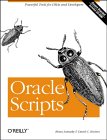
By: Brian Lomasky, David C. Kreines
Paperback - 204 pages (May 1998)
O'Reilly & Associates
This book provides a powerful set of tools for Oracle database administrators and developers. During their many years of administering, tuning, and troubleshooting Oracle databases, the authors have developed hundreds of useful scripts. Now you can instantly take advantage of their experience by putting these scripts to work at your own site. DBAs and developers are constantly reinventing the wheel. Most Oracle sites have similar requirements, problems, and crises, and at most of these sites DBA s and developers find themselves reinventing the wheel by writing the same kinds of scripts -- and too often they're writing them under pressure, in hit-or-miss and error-prone fashion. The scripts in this book are tried-and-true. They've been thoroughly tested in many different environments. You can use them right now to simplify the tasks you perform each day -- monitoring databases for reliability, protecting your database against data loss, improving performance, increasing security, and bui lding reports that provide insight into the inner workings of Oracle databases. You can also turn to these scripts in emergencies to diagnose system problems and repair databases when the pressure is on.
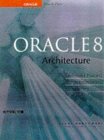
By: Steve Bobrowski
Paperback - 356 pages authorized edition (October 1997)
Osborne McGraw-Hill (Oracle Press)
The book design has two primary goals. First, the book is a basic/intermediate level presentation of the primary concepts and software architecture of Oracle8. After reading this book, any type of Oracle8 user will have a solid, big-picture understanding of how Oracle8 fits into the world of serious data management applications. Second, the book is an excellent planning guide that will help a current Oracle user server to migrate Oracle7 databases and corresponding database server administrators and application developers need to understand to work with Oracle8.
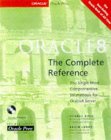
By: Kevin Loney, George K. Koch
Hardcover - 1300 pages (September 1997)
Osborne McGraw-Hill (Oracle Press)
Oracle8: The Complete Reference is completely updated to cover versions 7.0 through 8. The book is organized in 6 parts. Part I introduces database concepts. Part II discusses SQL, the Structured Query Language which allows programmers to process information to and from a database. Part III is the Hitchhiker's Guide to the Data Dictionary. Part IV discusses database design consideration. Part V is a big, alphabetical reference for virtually every Oracle command. Part VI lists the tables used in the book. The book offers both terrific coverage of using Oracle and a substantial command reference listing the syntax and sample usage for every major command. It also includes a new chapter called "The Hitchhiker's Guide to the Oracle Optimizer." This presents the SQL operations and tuning issues directed towards a beginner user audience. As with its predecessor, this book will include a CD-ROM. This is particularly valuable for readers for two reasons. First, since the book is large, having quick referencing capability on CD will be attractive to end-users. The sizeable reference section is perfect for electronic access. Secondly, the tables in the book will be accessible on the CD, so users will save both time and money.

By: Guy Harrison (Contributor), Lynnwood Brown (Contributor), Ahmed Alomari
Paperback Bk & CD-ROM edition (September 1997)
Prentice Hall
This kit includes three books: Oracle SQL highperformance tuning, Oracle database administration on UNIX systems, and Oracle and UNIX performance tuning. Three CD ROMs included. The complete professional's resource for building, managing, and optimizing Oracle databases! Oracle DBA Reference Library is an unparalleled practical resource for DBAs, database programmers, IT managers, and anyone who needs to make the most of Oracle database technology. Its three comprehensive, up-to-date books by world-class Oracle professionals, plus three CD-ROMs packed with tools and information, all for one great price!